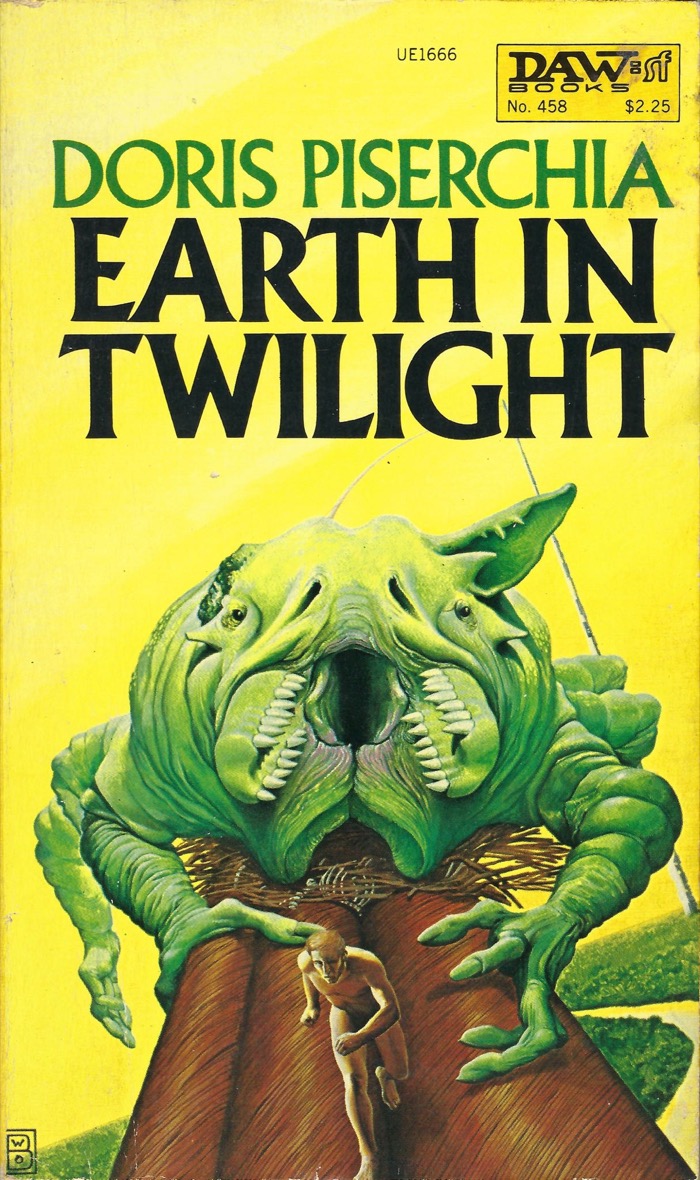Earth in Twilight
Reviewed date: 2019 Oct 26
Rating: 2
156 pages
What is it with Doris Piserchia and trees? The last book I read was Doomtime: The War of the World Trees, a bizarre book that featured trees six kilometers tall with root systems that spanned whole continents. In Earth in Twilight, the trees are even taller and grow so thickly over the entire globe that most life on Earth exists entirely within the forest canopy, miles above the ground.
Earth in Twilight reminds me of Hothouse by Brian Aldiss crossed with Midworld by Alan Dean Foster, but with the bizarre writing style unique to Doris Piserchia. She is a singular talent and a treasure.
Mankind has long since abandoned Earth. Now, Laredo Space Base sends a survey mission to determine if Earth is a suitable candidate for Project Deep Green: judicious release of a defoliant into Earth's atmosphere will kill the dense, miles-high forest and prepare the planet for recolonization.
Ferrer Burgoyne and another crew member arrive at Earth and dock their spacecraft at a steeple. The steeple is a space elevator. This immense structure extends from the Earth's surface far out into space, and simplifies access to the planet: simply dock the spaceship and take an elevator ride down to the surface.
Unfortunately, they are met by a steeple sentry who promptly eats Ferrer's crewmate. Ferrer escapes in the elevator and heads down towards the surface, pursued by the steeple sentry. The steeple sentry is an enormous, relatively intelligent creature that has apparently evolved since humanity abandoned the planet. This particular steeple sentry is named Whing, he lives in the steeple, and he considers it his job to defend Earth. He has no idea what these little "worms" are--he doesn't recognize them as people--and he's upset they've invaded his turf.
Ferrer escapes the steeple sentry and ends up falling in with a community of tree-dwelling vegetable people (who look human except their skin is green, their teeth are purple, and they absorb water through their skin.) Ferrer must find a way to contact his people, arrange to be rescued, and convince them to call off Project Deep Green--because Ferrer has realized that the life on Earth, although not human, is valuable and deserves protection.
Besides Ferrer and the steeple sentry Whing, we meet a number of intriguing characters. There is Pip, a vegetable-person conman. There's Kadooka, a village chief who hires Pip to save their village from a menacing ornad that's eating villagers. (Pip has no intention of combatting the ornad; he intends to take his payment in advance and skip out.) There's a community of descoes, a bizarre religious sect who hide their gender and often refuse to acknowledge the existence of gender at all. And there are the various monsters that roam the arboreal forest: ornads, snapes, ganutes.
Then there is Peru. He's a pestilence, a sentient disease. He slips into other beings, samples the thought in their brains, and possesses their bodies. Peru is evil. He kills and destroys for the sheer pleasure of it.
Peru happens upon Ferrer, and from Ferrer's mind, learns of the existence of other planets and of the teeming billions of human beings. Peru would love to destroy those billions: to sicken them, to watch the pain and the suffering and the destruction and death. Yes, Peru wants to escape Earth and prey on humanity, and Ferrer is his ticket off Earth.
The plot gets kind of muddy at this point (Piserchia either keeps things deliberately vague, or her descriptions are inadequate. Probably both.) A second survey expedition arrives at Earth, and Whing promptly kills them. Laredo goes ahead and launches Project Deep Green, and somehow Ferrer and Pip convince Whing and his friends to intercept the spacecraft and destroy it before it can release the defoliant.
Peru, meanwhile, is still attempting to escape by commandeering one of the spacecraft parked at the steeple. Ferrer foils that by blowing up the steeple. I think. Anyway Peru is dead, and steeple is destroyed, and poor Whing finds himself homeless. He'll have to find another abandoned steeple in which to live.
Ferrer is stranded on Earth, so it's not a happy ending for him.
Earth in Twilight has a more coherent plot than the other Piserchia books I've read. It still has the essential Piserchia style--the abrupt dropping of plot threads, a sense of randomness to the action, the whimsy and the gore. I'm not sure what to think about her style. I don't know that I like it, but I keep coming back for another fix. There's nothing else like it.
